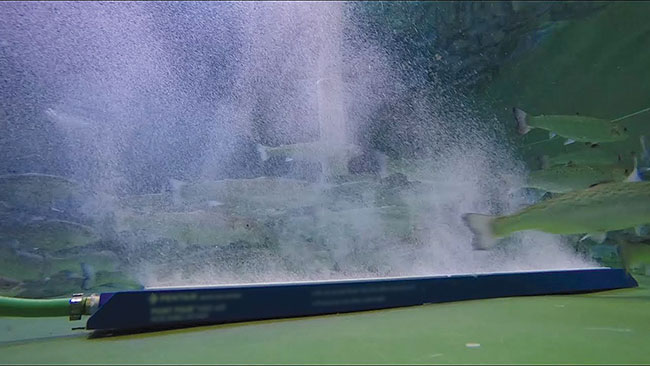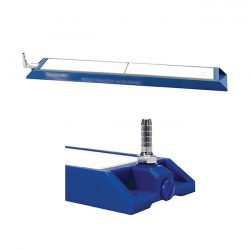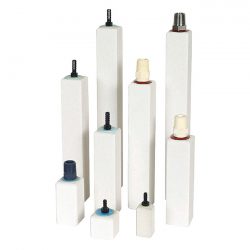
Features
Business Management
Systems management
Air stone choices and maintenance
June 19, 2020 By Ron Hill
 Diffusers produce a fine sheet of micro-bubbles which effectively oxygenate the water.
Diffusers produce a fine sheet of micro-bubbles which effectively oxygenate the water. The importance of diffusers and air stones to hatcheries cannot be overstated. If there is anything at a farm that needs to be of high quality, it is oxygen diffusers and air stones. Diffusers and air stones are delivering oxygen where and when it is needed most – there cannot be failures. They are inefficient by nature – contact time is limited to the time it takes for the bubbles to reach the surface and much oxygen is lost into the atmosphere – but are extremely effective in providing oxygen where it is needed.
Choosing the right oxygen diffuser
There are many types of diffusers and stones available; choose the right one for your farm and your application. Diffusers are generally plastic, or metal bodied with large ceramic stones inset. Oxygen is pushed through the ceramic stone creating a fine misty sheet of microbubbles. Microbubbles are desirable for their good surface-to-volume ratio, which allow excellent gas exchange with the water.

Diffusers with an upright barbed fitting can be easier to keep upright.
Diffusers need to be matched to their control flow meters and line oxygen pressure. Not all flow meters will work with ceramic diffusers and diffusers can have different maximum pressure ratings so make sure to match the diffuser to your system. Many plastic body diffusers exist, but they are not created equal. Some plastic body diffusers can be difficult – although the plastic body is tough they are often susceptible to flipping over and weights may need to be added. Extendable plastic track locks are susceptible to sections or end pieces twisting off in the tank.
The barbed hose fitting can be either perpendicular to the diffuser (it sticks straight up) or level with the stone (it comes out the end). Models with the hose fitting coming out the top prevent the stone from easily flipping over while descending and gives you the assurance the diffuser is still upright even if you can’t see it in the water. Select the style that works for the application; brass adaptors can be added to models with level fittings. It can be extremely frustrating to get a diffuser to flip over and sit properly on the bottom, especially with smaller stones.
Choosing the right air stone
Air stones are coarser than diffusers, deliver much larger bubbles and can deliver a much larger volume of gas. Air stones are much cheaper than diffusers but are much less efficient at adding oxygen to water. Air stones are often used for agitation as well as providing for fish metabolism; air is used instead of oxygen to provide agitation.

Air stones come in many sizes, provide large bubbles and are usually made of silica or aluminum oxide.
Like diffusers, there are many different stones out there. Choose stones with a larger pore size if the objective is agitation for a biofilter, etc. If the objective is to provide oxygen to fish, choose stones with a smaller pore size.
Many stones are notoriously brittle and are often found broken during shipping. Regular use is often very hard on the barbed hose fittings, which are usually made of plastic and tend to break off. Ask your supplier for the sturdiest models as they will likely be able to tell you which one their customers are happy with.
Maintenance
Keeping diffusers in top condition is a key component in oxygen and facility management. Multiple spare diffusers should be on hand for easy replacement. How diffusers are used and stored will determine how much maintenance they need. If the diffusers are left in the tank not running, they need to be inspected regularly and purged. As the diffuser sits unused in the bottom of the tank, water infiltrates the pores of the diffuser and works its way up the line. When the stone is turned on, water must be purged out of the diffuser by air pressure in the line before the diffuser can emit oxygen. Purging can cause delays in starting up the oxygen stone as the water is slowly pushed out – it is much more difficult to push water through the diffuser than it is oxygen.
Diffusers can also become clogged from the minerals or the organics in the water and should be brushed regularly. Stones that are not permanently submerged should be hung so they drip dry and should require less service. Ensure that diffusers are not allowed to freeze in cold weather unless they are dried and drained, even small amounts of water can cause cracks in the pores when it turns to ice.
Cracked or chipped diffusers emitting irregular bubble patterns should be removed and replaced immediately. Cracked stones should never be used again, amateur repair jobs can have disastrous consequences as stones can explode in spectacular fashion.
All stones should be serviced and sanded yearly. Each should be cut off the hose, the fitting inspected, set to dry and lightly sanded with 60 grit sandpaper. Sand lightly, only enough to clean out the tops of the pores. Inspect clogged or old diffusers – they may be serviced and re-used providing they are not cracked. Diffusers can be lightly acid washed with muriatic acid solution to remove stubborn mineral deposits or fouling that can clog the diffuser.
Whatever oxygen delivery device you choose, ensure it is tested and inspected regularly and find problems before you start using the oxygen.
Print this page
Advertisement
- MainStream Aquaculture bares multiple expansion plans
- New mudworm species viable feed for crab, shrimp broodstock, Philippines researcher says





